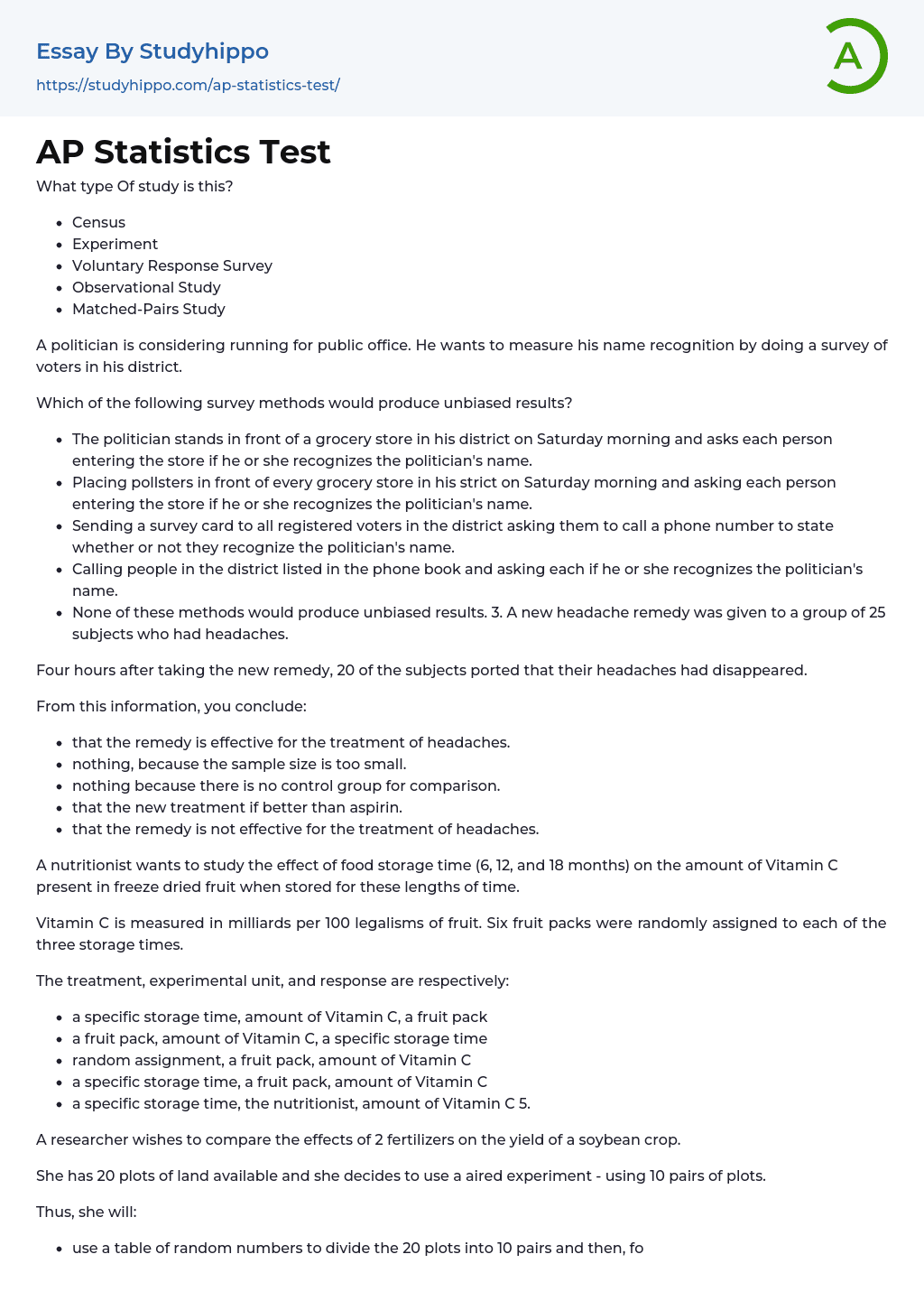This is a study of what kind?
- Census
- Experiment
- Voluntary Response Survey
- Observational Study
- Matched-Pairs Study
Considering a run for public office, an elected official plans to survey voters in his district to determine their level of familiarity with him.
Unbiased results would be produced by which survey method from the following options?
- The politician stands in front of a grocery store in his district on Saturday morning and asks each person entering the store if he or she recognizes the politician's name.
-
Placing pollsters in front of every grocery store in his strict on Saturday morning and asking each person entering the store if he or she recognizes the politician's name.
...
- Sending a survey card to all registered voters in the district asking them to call a phone number to state whether or not they recognize the politician's name.
- Calling people in the district listed in the phone book and asking each if he or she recognizes the politician's name.
- None of these methods would produce unbiased results. 3. A new headache remedy was given to a group of 25 subjects who had headaches.
After four hours of consuming the new treatment, 20 participants reported no longer experiencing headaches.
Your conclusion is based on this information:
- that the remedy is effective for the treatment of headaches.
- nothing, because the sample size is too small.
- nothing because there is no control group for
View entire sampleJoin StudyHippo to see entire essay
comparison.
The vitamin C content of fruit is calculated as milliards per 100 legalisms. A total of eighteen fruit packs were randomly allocated to three different storage times, with six packs assigned to each time period.
The following are the treatment, experimental unit, and response in order:
- a specific storage time, amount of Vitamin C, a fruit pack
- a fruit pack, amount of Vitamin C, a specific storage time
- random assignment, a fruit pack, amount of Vitamin C
- a specific storage time, a fruit pack, amount of Vitamin C
- a specific storage time, the nutritionist, amount of Vitamin C 5.
The aim of the study is to assess how two fertilizers affect the yield of soybean crops.
Thus, she will:
- use a table of random numbers to divide the 20 plots into 10 pairs and then, for each pair, flip a coin to assign the fertilizers to the 2 plots.
- subjectively divide the 20 plots into 10 pairs (making the plots within a block as similar as possible) and then, for each pair, flip a coin to assign the fertilizers to the 2 plots.
- use a table of random numbers to divide the 20 plots into 10 pairs and then use the table of random numbers a second time to decide upon the fertilizer to be applied to each pair.
- flip a coin
to divide he 20 plots into 10 pairs and then, for each pair, use a table of random numbers to assign the fertilizers to the 2 plots.
Each plant was put in a clay pot and given a specific amount of water on a weekly basis during the experiment. The final height of each plant was evaluated as a result.
Which option is not correct?
- The response variable is the plant height.
- The explanatory variables are the amount Of water and seed variety.
- Randomization was used to eliminate the effect of other possible factors upon the growth of plants.
- A possible uncontrollable factor in the experiment is any nutrients that might be present in the clay plots.
- Designed experiments give the best evidence of "cause-and-effect" relationships.
- Normal Distribution essays
- Probability Theory essays
- Variance essays
- Experiment essays
- Explorer essays
- Hypothesis essays
- Observation essays
- Qualitative Research essays
- Research Methods essays
- Theory essays
- Algebra essays
- Arithmetic essays
- Correlation essays
- Geometry essays
- Measurement essays
- Price Elasticity Of Demand essays
- Regression Analysis essays
- Statistics essays




